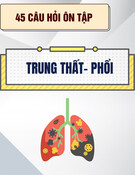
HUE JOURNAL OF MEDICINE AND PHARMACY ISSN 3030-4318; eISSN: 3030-4326 41
Hue Journal of Medicine and Pharmacy, Volume 14, No.6/2024
Quantitative determination of carvedilol in human plasma by high-
performance liquid chromatography using fluorescence detection
Nguyen Dang Thuy Anh1, Nguyen Huu Tien1*
(1) Faculty of Pharmacy, Hue University of Medicine and Pharmacy, Hue University
Abstract
Background: Carvedilol is a pharmaceutical substance listed in the “Regulatory requirements of
bioequivalence study reports for generic drugs containing APIs upon applying for marketing authorization”.
Therefore, a simple method for quantifying carvedilol in human plasma is desirable. Objectives: This study
aims to develop an HPLC method for quantitation of carvedilol in human plasma. Materials and method:
The blank human plasma was spiked with carvedilol standard. After optimizing the process, the method
was validated according to the guidelines for the validation of bioanalytical methods of US-FDA and EMA.
Results: Carvedilol and metoprolol as internal standard were extracted from plasma by protein precipitation
technique with acetonitrile. Plasma samples were eluted through a Zorbax Eclipse XDB-C8 (5 μm; 4.6 x
150 mm) column with an isocratic mobile phase consisting of 0.1% trifluoroacetic acid in water, acetonitrile,
and methanol (60:20:20; v/v/v). The analytical method met the criteria according to the US-FDA and EMA
guidelines for the bioanalytical method validation. Conclusion: The method can be applied to determine
carvedilol in biological fluid for pharmacokinetic research and bioequivalence assessment.
Keywords: carvedilol, human plasma, HPLC.
Corresponding Author: Nguyen Huu Tien
E-mail: nhtien@huemed-univ.edu.vn; nhtien@hueuni.edu.vn
Received: 5/1/2024; Accepted: 1/8/2024; Published: 25/12/2024
DOI: 10.34071/jmp.2024.6.5
1. INTRODUCTION
In recent years, cardiovascular diseases have
been increasingly recognized as one of the leading
causes of morbidity and mortality in developed
countries. In most cases, individuals with
cardiovascular diseases may experience symptoms
such as chest pain and fatigue, while in many
instances, individuals may remain asymptomatic
until they experience a heart attack [1]. Therefore,
early detection and treatment of these conditions
are of paramount importance. Carvedilol is a
nonselective β receptor blocker with vasodilatory
and antioxidant properties, which is clinically used
to treat cardiovascular disorders such as mild to
moderate hypertension or angina pectoris [2].
All over the world, several methods have been
published for the estimation of carvedilol in rat
plasma [3], human plasma [4-6], and human urine
[7] using high-performance liquid chromatography
(HPLC) coupled to a fluorescence detector [5], [6], [8],
ultraviolet detector [7], [9], liquid chromatography
coupled to tandem mass spectrometry[10],
gas chromatography coupled to tandem mass
spectrometry [11] and ultra performance liquid
chromatography (UPLC) coupled to tandem mass
spectrometry [3, 12]. However, these methods
have several limitations, including complex sample
preparation procedures, lengthy analysis times, and
the use of hazardous solvents that pose risks to both
human health and the environment. In methods
involving mass spectrometry (MS) coupling,
reports have shown high sensitivity and low limit of
quantitation (LLOQ). The best LLOQ of 0.05 ng/mL
was reached when using the UPLC-MS/MS method.
However, these methods are costly and require
specialized equipment, making them not suitable
for all laboratories. Thus, in this paper, we present
a simple, accurate, and cost-effective HPLC method
using a fluorescence detector with a simple sample
preparation for quantifying carvedilol in human
plasma.
2. MATERIALS AND METHODS
2.1. Materials
Carvedilol (98%) and metoprolol tartrate
(100.37%) were provided by Toronto Research
Chemicals, Canada, and National Institute of Drug
Quality Control, Vietnam, respectively. HPLC-grade
acetonitrile, methanol, and all other analytical grade
chemicals were purchased from Merck, Darmstadt,
Germany. Ultrapure water was obtained from an
ultrapure water system, AltoTOC UF, AVIDITY, UK.
Human plasma was supplied by National Institute of
Hematology and Blood Transfusion, Vietnam.
The HPLC system of Shimadzu, Japan consisted of
a pump LC-20AD, an online degassing unit DGU-20A,






























